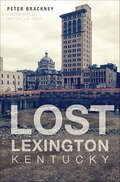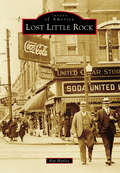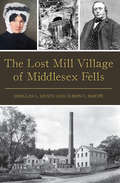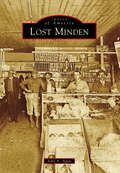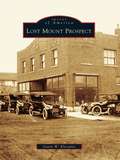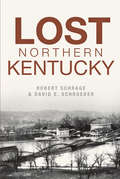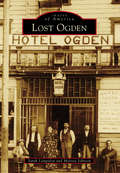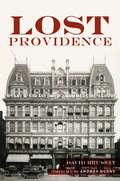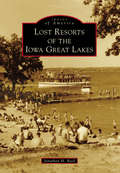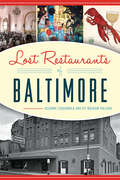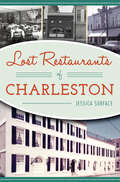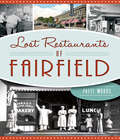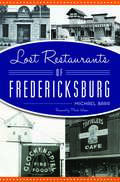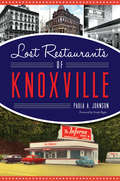- Table View
- List View
Lost Lexington, Kentucky (Lost)
by Peter BrackneyLexington has dozens of well-restored landmarks, but unfortunately so many more are lost forever.The famous Phoenix Hotel, a longtime stop for weary travelers and politicians alike, has risen from its own ashes numerous times over the past centuries. The works of renowned architect John McMurtry were once numerous around town, but some of the finest examples are gone. The Centrepointe block has been made and unmade so many times that its original tenants are unknown to natives now. Join local blogger, attorney and preservationist Peter Brackney as he explores the intriguing back stories of these hidden Bluegrass treasures.
Lost Little Rock
by Ray HanleyLittle Rock is a sprawling city of about 200,000 at the center of a metropolitan area of more than 500,000 people, with many residing in bedroom communities in adjoining counties. Arkansas's capital city is much like the rest of Middle America with its outlying suburbs, gated communities, and shopping centers miles from the historic core. A century ago, however, Little Rock was markedly different and served a population of fewer than 50,000. The majority of citizens lived within blocks of the town center and did business downtown along rows of shops that, in many cases, dated to the late 1800s. Images of America: Lost Little Rock uses vintage photographs to reflect upon earlier times and the rich retail landscape that once filled the town. By exploring the legacies of buildings that have since been demolished, repurposed, or destroyed by fire, these images provide a sense of Little Rock's lesser-known heritage.
Lost Maine Coastal Schooners: From Glory Days to Ghost Ships (Lost Ser.)
by Ingrid GrenonDramatic true stories of New England maritime history, with photos. Large, wooden-hulled schooners graced the seas of coastal Maine for more than a century as vessels of trade and commerce. With the advent of steam-powered craft, however, these elegant four-, five-, or six-masted wooden ships became obsolete and vanished from the harbors and horizons. The Edward Lawrence, the last of the six-masters, became her own funeral pyre in Portland Harbor, burning to ash before everyone&’s eyes. The Carroll A. Deering washed ashore with no trace of her crew, empty as a ghost ship except for three cats and a pot of pea soup still cooking on the stove. In this testament to the beauty of the Maine coastal region, maritime history enthusiast Ingrid Grenon tells the story of these magnificent relics of the bygone Age of Sail and celebrates the people who devoted their lives to the sea.
Lost Metairie (Lost)
by Catherine CampanellaFrom ancient bayous to beloved old businesses, Metairie has changed dramatically over generations. And many of those landmarks are lost to time. The lake, railroads and a beach resort were popular features in the early days. A streetcar ran through the short-lived City of Metairie Ridge, where gambling houses and dog tracks contributed more tax dollars than did the few residents. Old Bucktown was famous for its seafood. Fat City, once notorious for its nightlife, has seen better days. Author Catherine Campanella takes a look back at the schools, shops, bars, restaurants, alligator farms, bowling alleys, drive-ins and movie theaters from a bygone era.
Lost Mill Village of Middlesex Fells, The (Brief History)
by Alison C. Simcox Douglas L. HeathOne of the earliest mill communities in the Massachusetts Bay Colony formed along Spot Pond Brook, a few miles north of Boston. Thomas Coytmore built the first mill in 1640 at the brook’s downstream end in “Mistick Side” (present-day Malden). Other mills sprang up along the brook as well. Today, most of Spot Pond Brook is hidden in culverts beneath the busy streets of Malden and Melrose. However, remnants of the lost mill village of Haywardville—foundations, millruns and ponds and waterfalls—are preserved within Middlesex Fells Reservation, part of Boston’s world-famous Metropolitan Park System. Authors Douglas L. Heath and Alison C. Simcox trace the history of this thriving early American community.
Lost Milwaukee (Lost)
by Carl SwansonFrom City Hall to the Pabst Theater, reminders of the past are part of the fabric of Milwaukee. Yet many historic treasures have been lost to time. An overgrown stretch of the Milwaukee River was once a famous beer garden. Blocks of homes and apartments replaced the Wonderland Amusement Park. A quiet bike path now stretches where some of fastest trains in the world previously thundered. Today's Estabrook Park was a vast mining operation, and Marquette University covers the old fairgrounds where Abraham Lincoln spoke. Author Carl Swanson recounts these stories and other tales of bygone days.
Lost Minden (Images of America)
by John A. AganMinden has transformed quite a bit since Charles Vedeer founded it in 1835. The town has suffered damages of the Civil War and Reconstruction and between 1872 and 1933 the devastation of five fires and a killer tornado. Despite disaster, Minden continues to progress, but adaptation and rebuilding have caused many familiar landmarks to vanish from the local landscape. The 1902 fire led to the enactment of a city ordinance banning wooden structures downtown; as a result, many edifices were reconstructed. Today, not a single building in the business district predates the 1870s, and the roles of those still standing--such as the First National Bank, which is expected to reopen as a restaurant--are continually changing. In 1918, another fire destroyed the Minden Lumber Mill, the town's largest industry. Later in the 20th century, the development of a city government complex demolished an entire shopping district, the 1905 Webster Parish Courthouse, and Minden City Hall. Lost Minden captures catastrophes, celebrations, storefronts, and back streets that otherwise only remain in memories. ?John Agan is a lifelong Minden resident who has been actively involved in local history writing and research for more than 30 years. In the course of these activities, he accumulated most of the vintage photographs in this volume that depict the Minden that has since been "lost."
Lost Mount Prospect (Images of America)
by Gavin W. KleespiesMount Prospect dates back to the 1840s. The village has a fascinating legacy as an immigrant community, an ambitious small town, an early progressive suburb, and a classic postwar community. However, few of today's residents are aware of this legacy. Much of Mount Prospect's past has been overshadowed by the incredibly rapid development of the past half century. The population of Mount Prospect in 1950 was around 4,000 people, the population was almost 19,000 by 1960, and today it approaches 60,000. This amazingly rapid development fundamentally changed how Mount Prospect saw itself and redefined the community's landscape. Many of the older buildings were demolished to make way for new developments or were modernized and are now hard to identify. The farms and early industries were replaced with houses and shopping areas. By the time this rapid development was over, it was hard to see what had been here before. Lost Mount Prospect is an examination of this history. It is a look at the village through the lens of what no longer exists.
Lost Mysteries: Secrets, Legends & Treasures of the Past
by Paige TowlerHistory is full of the weird, wild, and wacky—and in this interactive adventure book with 250+ photos, middle grade readers uncover the incredible mysteries of our worldKids ages 7+ will discover why history is the coolest subject ever with mind-blowing stories about ancient civilizations, dinosaurs, hidden treasures, pirates and moreHow were the ancient Egyptian pyramids built and who was King Tut? How did the Titanic sink and where is Blackbeard&’s pirate treasure? Did scientists really find a new dinosaur in the basement of a museum, or an entire city buried underneath the Amazon rainforest? And…why was a 2,000-year-old block of butter stuck in a swamp?In Lost Mysteries, you&’re on the case! This incredible fact file provides a thoroughly researched and up-to-date look at every mystery and delves into clues, theories, and exciting new finds from the past that still need to be explored. The secrets of the past are yours to uncover!Start sleuthing to find out about the most incredible mysteries of our world, such as: Why some ancient civilizations disappeared without a traceWhere you can find Bigfoot and other mythical monstersWhy a famous king was buried underneath a parking lotHow the art thieves who stole the iconic Mona Lisa were caughtAnd so many more thrilling facts and theories!This collection of exciting, real-life stories is packed with facts and groundbreaking science that takes readers on a captivating journey to unlock the secrets of the past. It&’s the perfect book for kids who love incredible history stories, parents looking for fun boredom busters or gifts for curious kids, or middle grade teachers who are looking to enrich their social studies curriculums.
Lost Northern Kentucky (Lost)
by Robert Schrage David E. SchroederNorthern Kentucky has a unique location as the gateway between the North and the South. Many of its historic businesses, religious structures, homes and buildings were lost to time. Just after the Civil War, Daniel Henry Holmes purchased a large Victorian-Gothic house he named Holmesdale, better known as Holmes Castle. By the 1890s, the Latonia Racetrack had two hundred stables to accommodate horses and space for one hundred bookmakers. The Motordrome at the Ludlow Lagoon Amusement Park had seating for eight thousand people. Authors Robert Schrage and David Schroeder detail the fascinating history of Northern Kentucky's lost treasures.
Lost Oasis: In Search Of Paradise
by Robert TwiggerBestselling author of ANGRY WHITE PYJAMAS, BIG SNAKE and VOYAGEUR enters into the desert in search of a lost oasis'Last night my son wanted to appease me because of some annoyance he had caused. "Show me your desert things," he said, "show me your crystals and stones." However tired and grumpy I might be, he knew how to revive me. I unwrapped everything from its newspaper roll. The chipped flint knives, the silica glass arrowheads, ancient porous pottery shards I'd found in the Gilf, fossils, the jawbone of a gazelle, palm nuts so desiccated they were like stone . . .'Robert Twigger's latest journey is in search of paradise: a desert adventure in the footsteps of seasoned explorers such as Theodore Almasy (the Inspiration for THE ENGLISH PATIENT) who tried to locate the lost oasis of Zezura, reportedly home to hoards of treasure, flocks of birds and a lush, verdant valley.The Egyptian Sahara is one of the most arid and hostile environments on earth. But it is also a wonder of desolate beauty, where in the ultra-clear light of the desert you can see for miles.Armed with plenty of water and a homemade wooden trolley (his Lada being too heavy for the sand), Twigger embarks on a desert trip ilke no other . . .
Lost Oasis: In Search Of Paradise
by Robert TwiggerBestselling author of ANGRY WHITE PYJAMAS, BIG SNAKE and VOYAGEUR enters into the desert in search of a lost oasis'Last night my son wanted to appease me because of some annoyance he had caused. "Show me your desert things," he said, "show me your crystals and stones." However tired and grumpy I might be, he knew how to revive me. I unwrapped everything from its newspaper roll. The chipped flint knives, the silica glass arrowheads, ancient porous pottery shards I'd found in the Gilf, fossils, the jawbone of a gazelle, palm nuts so desiccated they were like stone . . .'Robert Twigger's latest journey is in search of paradise: a desert adventure in the footsteps of seasoned explorers such as Theodore Almasy (the Inspiration for THE ENGLISH PATIENT) who tried to locate the lost oasis of Zezura, reportedly home to hoards of treasure, flocks of birds and a lush, verdant valley.The Egyptian Sahara is one of the most arid and hostile environments on earth. But it is also a wonder of desolate beauty, where in the ultra-clear light of the desert you can see for miles.Armed with plenty of water and a homemade wooden trolley (his Lada being too heavy for the sand), Twigger embarks on a desert trip ilke no other . . .
Lost Ogden
by Sarah Langsdon Melissa JohnsonFrom a fur-trapping fort to a thriving metropolitan community, change has always been a part of Ogden's history. Settled in 1850 by Mormon pioneers, Ogden was forever transformed by the arrival of the transcontinental railroad in 1869. As horse-drawn carriages gave way to motor cars, a busy downtown district grew up around Ogden's Union Station and notorious Twenty-fifth Street. Landmark businesses, such as J.G. Read & Brothers Company and the Broom Hotel, became a part of the city's unique identity. Also unique to the city were its celebrations and special events, like parades, musicals, and sporting competitions. While change has always come to Ogden, the memories remain.
Lost Providence (Lost)
by Andres Duany David BrussatProvidence has one of the nation�s most intact historic downtowns and is one of America�s most beautiful cities. The history of architectural change in the city is one of lost buildings, urban renewal plans and challenges to preservation. The Narragansett Hotel, a lost city icon, hosted many famous guests and was demolished in 1960. The American classical renaissance expressed itself in the Providence National Bank, tragically demolished in 2005. Urban renewal plans such as the Downtown Providence plan and the College Hill plan threatened the city in the mid-twentieth century. Providence eventually embraced its heritage through plans like the River Relocation Project that revitalized the city�s waterfront and the Downcity Plan that revitalized its downtown. Author David Brussat chronicles the trials and triumphs of Providence�s urban development.
Lost Province: Adventures in a Moldovan Family
by Stephen HenighanStephen Henighan, a Romanian grammar book and hours of language tapes under his belt, billets with a family as an English teacher in Moldova, a country born from the dismantling of Romania during World War II. <P><P>As a Westerner in this "lost province" and former Soviet republic, Henighan feels he’s an unnerving disappointment for many Moldovans, especially to the MTV-addicted, twenty-year-old Andrei.
Lost Resorts of the Iowa Great Lakes (Images of America)
by Jonathan ReedSince the first rustic vacation retreat for hunters and fishermen was built in 1871, Okoboji and the Iowa Great Lakes have been a drawing card for families, generation after generation. Over the decades, dozens of vacation resorts, from the magnificent Hotel Orleans on Big Spirit Lake to the iconic Inn on West Okoboji, have lured happy summertime visitors. Just mentioning the name of a resort often evokes memories of swimming, boating, fishing, waterskiing, or just good times spent with friends and family. However, most of these vacation resorts are now gone--The Inn, Manhattan Beach Hotel, Templar Park, and Crandall's Lodge have all been demolished. Vacation Village has become Village West, and the Crescent Beach resort, which at one time boasted over 100 apartments or cottages, now has fewer than 30 motel-style units. Gone too are dozens of friendly mom-and-pop cottage resorts all around the lakes, replaced by condominiums and private residences.
Lost Restaurants of Baltimore (American Palate)
by Suzanne Loudermilk Kim Watson PollardBaltimore's unforgettable dining scene of the past is re-visited here in thirty-five now shuttered restaurants that made their mark on this city.Haussner's artwork. Coffey salad at the Pimlico Hotel. Finger bowls at Hutzler's Colonial Tea Room. The bell outside the door at Martick's Restaurant Francais. Details like these made Baltimore's dining scene so unforgettable. Explore the stories behind thirty-five shuttered restaurants that Baltimoreans once loved and remember the meals, the crowds, the owners and the spaces that made these places hot spots. Suzanne Loudermilk and Kit Waskom Pollard share behind-the-scenes tales of what made them tick, why they closed their doors and how they helped make Baltimore a culinary destination.
Lost Restaurants of Central Ohio and Columbus (American Palate)
by Christine Hayes Doug Motz Liz LessnerFrom remote diners to downtown political havens, the restaurants of central Ohio satisfied palates for generations. In the era of Sunday drives before interstates, fabulous family-owned restaurants were the highlight of the trip. Sample the epicurean empires established by Greek, Italian, German and Chinese families. Recall the secrets of Surly Girl's chandelier, the delicious recipes handed down by chefs and the location of Flippo the Clown's former jazz hideaway. Following their previous book, Lost Restaurants of Columbus, authors Christine Hayes and Doug Motz deliver a second helping of unforgettable establishments that cemented central Ohio's reputation for good food and fun. That includes eighteen destination eateries in fifteen surrounding towns.
Lost Restaurants of Charleston (American Palate)
by Jessica SurfaceDiscover the culinary heritage of South Carolina&’s famous port city with this guide to historic restaurants that have come and gone. Once a sleepy city of taverns and coffeehouses, Charleston evolved into a culinary powerhouse of innovative chefs and restaurateurs. Jessica Surface, founder of Chow Down Charleston Food Tours, celebrates the city&’s rich cultural history in Lost Restaurants of Charleston. The origins of she-crab soup trace back through Everett&’s Restaurant. The fine dining of Henry&’s evolved from a Prohibition-era speakeasy. Desserts were flambéed from the pulpit of a deconsecrated church at Chapel Market Place, and Robert&’s hosted Charleston&’s famous singing chef. From blind tigers to James Beard Awards, Surface explores the stories and sites that give Charleston its unique flavor.
Lost Restaurants of Detroit (American Palate)
by Paul VachonThrough stories and recipes nearly lost to time, author Paul Vachon explores the history of the Motor City's fine dining, ethnic eateries and everything in between. Grab a cup of coffee - he's got stories to share.While some restaurants come and go with little fanfare, others are dearly missed and never forgotten. In 1962, patrons of the Caucus Club were among the first to hear the voice of an eighteen-year-old Barbra Streisand. Before Stouffer's launched a frozen food empire, it was better known for its restaurants with two popular locations in Detroit. The Machus Red Fox was the last place former Teamsters president Jimmy Hoffa was seen alive.
Lost Restaurants of Fairfield (American Palate)
by Patti WoodsThe culinary history of Fairfield, Connecticut, brims with bygone and beloved eateries and watering holes. Discover some of these lost classics, from the Sun Tavern--where George Washington enjoyed a few victuals--to the Scenario, where local celebrities always had a seat reserved at the bar. The best doughnuts in town were at the corner of Post and Beaumont at Devore's, while Art Green served up his famous chocolate cream pies at the Pie Plate. Join author Patti Woods for a generous serving of nostalgia complete with nachos from Sidetrack's, chili from Kuhn's and maybe even an ice cold beer from the Driftwood.
Lost Restaurants of Fredericksburg (American Palate)
by Michael BarrFrom soda fountains to beer gardens, celebrate the founders of Fredericksburg's feasts.Fredericksburg's heritage of dining hospitality is full of unforgettable corner booths and legendary roadside stands. The Crown Saloon gave pioneer teamsters a welcome chance to wet their whistle, while the Manhattan Cafe brought pickled herring and other delicacies of the 1920s to the Hill Country frontier. At the state's first wine festival, Haversack Winery treated guests to a 2,100 lb. chunk of cheddar cheese along with performances from The Ballet Folklorico España and Pehl's Old Time Band. The Wild Game Dinner raised a healthy chunk of change for worthy Gillespie County causes. Michael Barr lines up a buffet of iconic Fredericksburg eateries that will have readers smelling Noble's brisket through the butcher paper and hearing the sizzle of Oma Koock's Schnitzel.
Lost Restaurants of Grand Rapids (American Palate)
by Norma LewisGrand Rapids restaurants have served up meals and memories since the city's earliest days. At Bentham's, one of the first downtown restaurants, customers without money to eat could trade an animal pelt for supper. John Sebaitis trained his German shepherd, Spooky, to serve beer to the patrons at his tavern. And a seventeen-year-old Gerald R. Ford worked part time as a server and dish washer at Bill's Place. Join Norma Lewis as she explores the history of Grand Rapids' most beloved eateries and the stories behind them.
Lost Restaurants of Knoxville (American Palate)
by Paula A. JohnsonOver the past 225 years, Knoxville dining has come full circle—from early taverns and saloons to upscale continental cuisine and back to the roots of local eating experiences. Greek immigrants Frank and George Regas founded the legendary Regas Restaurant, which operated for 90 years, spreading culinary influence throughout the entire city. Early country music stars frequented Harold’s Deli while visiting the city to perform on Tennessee’s first live radio shows. Guests from around the world sat 266 feet in the air at the Sunsphere Restaurant, a fine dining establishment run by the Hardee’s Corporation during Knoxville’s World’s Fair. Discover these and many more fascinating stories as author and historian Paula Johnson dives back in time through the stories of the city’s great restaurants.
Lost Restaurants of Louisville (American Palate Ser.)
by Michelle Turner Stephen HackerLouisville was home to fine cuisine long before the famous restaurant rows on Bardstown Road, Frankfort Avenue and East Market Street. Mazzoni's served the area's first rolled oyster. At the C-54 Grill, guests dined inside a remodeled aircraft, and Kaelin's prepared its classic cheeseburger. Hasenour's sauerbraten and Hoe Kow's war sui gai are two dishes that still make local mouths water when mentioned. Authors Stephen Hacker and Michelle Turner revisit the vivid personalities, celebrated spaces and unique recipes that made Louisville's historic eateries unforgettable.
